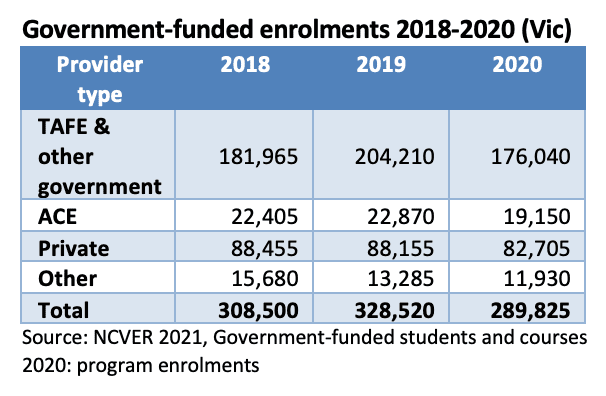Labor’s election commitments for VET include:
- 45,000 additional fee-free TAFE places
- 420,000 existing government-funded VET places being converted to fee-free places in TAFE (noting that some of these places may have gone to TAFE anyway but the students will benefit from not paying a student fee)
- 70% of Commonwealth government funding for VET going to TAFE and 30% to other VET providers
- 10,000 new energy apprenticeships
- some additional training for the hospitality and accommodation sectors, and
- support for microcredentials but no mention of government funding being allocated to them.
When releasing their costings Labor stated that the differences between their figures and the Coalition’s included their extra investments in areas like VET. It therefore appears that the funding for their 465,000 fee-free TAFE places is additional to the $3.7B in extra funding which the outgoing Coalition government included in this year’s Budget.
The Coalition anticipated that this extra funding would deliver approximately 800,000 additional VET places over the next five years (and their intention was to allocate some of the funding to full qualifications and some to fund short courses/microcredentials).
Fee-free TAFE
When fee-free TAFE was introduced in Victoria in 2019 there was an initial increase in government-funded TAFE enrolments after a decline in the preceding year (when the policy was announced in mid-2018 prospective students deferred enrolment until January 2019 when Free TAFE commenced). Note that:
- government-funded enrolments in TAFE in Victoria subsequently declined in 2020 despite the Free TAFE scheme continuing and even being expanded, and
- government funded enrolments in private and ACE providers in Victoria were unaffected in 2019 by Free TAFE and, like TAFE enrolments, private and ACE provider enrolments also subsequently declined in 2020.

Based on the Victorian experience, the impact of fee-free TAFE on non-TAFE providers is likely to be modest because of the flexibility in most States and Territories, where governments allow the providers they fund some discretion in relation to the student fees they charge.
That is not the case in New South Wales and Western Australia, and it is in these two jurisdictions where fee-free TAFE could negatively impact non-TAFE providers because these governments mandate the student fees which all government-funded providers must charge.
It is unclear if the NSW and WA governments will look to allow non-TAFE providers to reduce their student fees to match the Commonwealth’s fee-free TAFE offer. If they choose not to, then fee-free places in TAFE will be more attractive to students, although the total number of fee-free TAFE places each year will be only approximately 10 per cent of all government-funded places.
70% of government funding to TAFE
In 2020 TAFE Institutes received 56 per cent of the $273m in Commonwealth funds allocated through the VET Student Loan scheme. Non-TAFE providers received 44 per cent of the VSL funding.
If implemented uniformly across the board Labor’s policy will see non-TAFE providers lose 14% of their current VSL funding (ie a total of $38.25m) and this funding would instead be allocated to TAFE Institutes.
National Skills Agreement
Based on media reports and evidence given in Senate Estimates hearings, it is understood that one of the reasons why States, Territories and the former Coalition government were not able to agree on the details of the new National Skills Agreement was State and Territory governments’ concerns about the impact of the introduction of more nationally consistent and efficient pricing mechanisms for VET funding.
Given Labor has not indicated it is looking to pursue the same policies I expect negotiations on the National Skills Agreement will be less contentious and the new Agreement should be finalised in the next few months – for introduction potentially from January 2023.
————————————–
The above details are extracted from a comprehensive briefing provided to subscribers to our sector updates.




